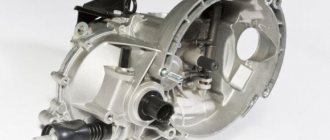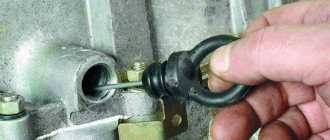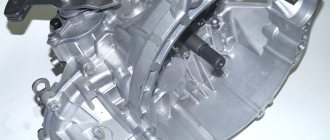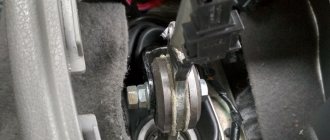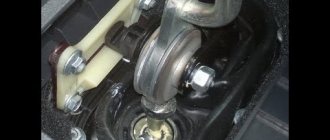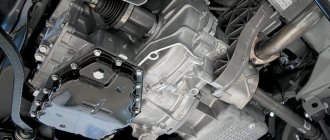In July, VAZ boxes had not yet been installed in Khreya.
There are also jambs in imported boxes... I couldn’t resist and went today to replace the fifth gear gears. The master said that there are repairs of new car boxes, including complex ones. We put my car on a lift, removed the wheel and gained access to the fifth gear cover: We removed the cover and saw the gears: They are not very easy to remove, special pullers are used. And it's not fast in terms of time. To my question - why don’t you heat, the master answered - only Armenians heat. In the end, everything was done in about two hours with short breaks. Elf 75w/80 oil, poured into TO-1 at mileage 15450 (now 25200), is as clean as a tear. They poured it back. Just in case, I had 700 grams left in the bottle after the replacement; about 100 of them were useful for refilling (they spilled a little during disassembly). Now about impressions. At a speed of 105 km/h I took pictures of the tidy 1. BEFORE and 2. AFTER: 1. 2. Taking pictures on the go is not very convenient, but the difference in speed at this speed was about 300 rpm. Maybe a little more. It’s a pity that I removed the multitronics, otherwise the numbers (and not the arrow) would have been more accurate. A few more photos so you can compare my turns with yours:So far I have driven only 60 km after the replacement, so there is not enough data. But the big plus of the replacement is definitely visible - at a speed of 120 km/h the strong hum stopped appearing. It doesn’t exist at 130 km/h or at 140. I didn’t accelerate anymore. The silence in the cabin is unusual, but very pleasant. I also misled myself. Before leaving for the service station, I reset the readings of the standard BC, and upon arrival I saw a consumption of 8.6 liters. Of course I did, the route was along the M5 Ural, which is now in perfect condition on my route. Well, winter wheels help increase fuel consumption. Before returning home, I reset the BC again, and upon arrival I discovered the consumption was 8.0. At the same time, I stepped on the gas even more seriously in order to test the new gears. Thought... Consumption cannot drop so sharply, miracles don’t happen. And only half an hour later I remembered that I was driving to the service on AI 92 gasoline, network Sh, and before the road I filled it back with 30 liters of the same 92, but network L. Here everything fell into place, everything is fine with consumption and there are really no miracles. During further operation I will monitor the consumption, but I don’t expect any significant changes. Regarding elasticity. Now, of course, you can’t engage fifth at 55 km/h. A reasonable minimum is 70 km/h, and 80 is better. By the way, the prompt has somehow adapted and now lights up the green arrow up at a speed of 75 km/h. The fourth one will now have to be tucked in more often, but this is for the best - overtaking will occur with a reserve. If you have a cruise, such a fifth is only a plus and a joy.
We understand the features of manual gearboxes from the Renault-Nissan alliance for the new Russian compact crossover.
Today, future owners of LADA XRAY are offered to purchase a car in two versions: a foreign set with an engine from the Renault-Nissan H4M alliance (1.6 l. 110 hp) and a French manual gearbox JH3, a Russian version with a new engine 21179 (1.8 l. 122 hp) produced by JSC AVTOVAZ and an automated mechanical transmission LADA. A little later, official dealers will have a symbiosis of our engine 21129 (1.6 l. 106 hp) and the foreign JR5 gearbox of the Renault-Nissan alliance, which is already used on LADA Vesta cars.
General points
In this material we will look at the differences between the JH3 and JR5 manual transmissions, which are provided for the new compact crossover. Both gearboxes are largely identical in design, but differ in clutch release units, gear ratios in the box, gear shift mechanisms and passenger comfort. Both one and the other gearbox for XRAY are made using a two-shaft design and have synchronizers for all forward gears, which are combined with the differential and final drive. A 3-cone synchronizer is used for first and second gears. For the third, fourth and fifth, conventional synchronizers are used. All boxes have foolproof protection and block the engagement of reverse gear while moving forward. Both boxes are filled with gear oil during production, the service life of which is equal to the service life of the entire car. Therefore, it is not replaced during scheduled vehicle maintenance.
Visual differences
The clutch release unit of the JHZ gearbox is a cable switch connected to the clutch pedal. The JR5 transmission clutch release assembly is a hydraulic slave cylinder. The working cylinder is connected by a pipeline to the main cylinder, the rod of which is acted upon by the clutch pedal. The JNZ gearbox is controlled using a rigid rod, and the JR5 gearbox is controlled using two flexible cables. As a result, engaging the gears of a gearbox designed for a Russian engine will be more comfortable than it is with a gearbox for an Alliance engine. This will especially noticeably affect the switching principle itself, which will be easier and without the clicking characteristic of boxes with traction control. The advantage of the JH3 gearbox will only be revealed at high speeds. The larger gear ratios of 3,4, 5 speeds allow the car to pick up speed faster and, as a result, overtake faster. In terms of maximum speed, this gearbox also outperforms the JR5 gearbox for the Russian engine. The maximum speed with the Russian unit will be lower by 5 km/h. But the number of engine revolutions at the same speed for a pair with JR5 will be lower.
In terms of fuel consumption, according to the passport data, the pair Renault-Nissan H4M (1.6 l. 110 hp) and the French manual gearbox JH3 will be more economical than our engine 21129 (1.6 l. 106 hp) and the foreign gearbox JR5 of the Renault alliance -Nissan. According to the data presented on the official LADA website, consumption in the combined cycle will be less by 0.5 liters, and on the highway by 0.3 liters. The differences in fuel consumption are not so great, and if the owner is interested in lower vibration loads on the gearbox lever and easier gear shifting, then his choice will be a kit with a Russian engine and a French gearbox. Another important factor will be the price of T.O. Components for a domestic unit are cheaper than similar parts for a foreign counterpart.
Choosing a high-quality and reliable transmission is one of the most important points when choosing and purchasing a new car. Which gearbox, of those proposed as a transmission for the Lada XRay, will best meet the expectations and needs of potential buyers can be found out in this article.
What gearboxes are installed on X-Ray
The choice is not very large - the manufacturer offered only two options in the line of available transmissions. However, the proposed types of boxes are quite capable of meeting the needs of any domestic driver.
Available for this model are: a five-speed robotic gearbox - AMT and a five-speed manual transmission. What they are needs to be explained in more detail.
5-speed manual transmission
A manual gearbox for the Lada XRay, according to many experts, will become one of the most popular vehicle equipment options. The manual transmission will be a French development, successfully used by the Renault concern, which in turn was provided to equip many Renault and AvtoVAZ models. The tall Lada XRay hatchback with front-wheel drive was no exception. This box shows good results and works like a clock.
The service life and resource of the box, previously used by the French manufacturer to equip the second generation Renault Logan, do not raise any doubts about its quality and durability. It is quite unpretentious to use and rarely requires major repairs.
Previously, this manual transmission was already successfully used in the assembly of the Lada Vesta, released for sale in November 2015. As reviews from Vesta buyers show, this unit does not cause any complaints in operation, so it will be a worthy choice for every Lada X-Ray buyer.
The only question that a potential buyer may have is some imbalance in the power of the motor. For some reasons, the designers created quite strict frameworks when assembling power units, so the manual transmission is used only in conjunction with two not very powerful engines. The Russian VAZ-21129 engine (1.6 liters, 106 horsepower) and the Japanese H4Mk (1.6 liters, 110 horsepower) are weaker than the VAZ-21179 engine (1.8 liters, 122 hp), which is only available with AMT. For example, in the most budget version of X Ray, the power is 106 hp. may not be sufficient to provide the required vehicle dynamics.
5-speed robotic automatic transmission (AMT)
As for the automatic transmission, AvtoVAZ used its own development – a robotic five-speed transmission with the ability to “intercept” control into manual mode. It will be possible to use the “robot” proposed by the developer to equip the Lada XRay only in the configuration of the power unit together with the VAZ-21179 engine, which has a volume of 1.8 liters and a rated power of 122 hp.
You can learn in more detail about how exactly the automatic transmission of a domestic manufacturer functions in numerous videos that were created by both independent experts and journalists from major automotive publications. In general, the performance of the variator was considered quite good, taking into account the latest adjustments from the manufacturer.
The disadvantages of AMT include the tendency to automatically downshift when climbing a steep slope. If the car begins to reduce power, there is a risk of losing momentum when overtaking on this hill (despite the built-in electronic stability control). The incorrect setting of the traction control system, which muffled engine speed when the load-bearing front wheels slipped, also contributed to this misunderstanding. Since these nuances were noticed during the first test drives, there is hope that the manufacturer corrected these shortcomings in time. As a last resort, it is recommended to take over manual control by switching the variator.
The second nuance is common to all automatic transmissions. One way or another, the electronics “slows down” a little with upshifts or downshifts, so there are some delays in the operation of the mechanism. An experienced driver with manual transmission control will receive significantly better vehicle acceleration performance than even the most advanced automatic.
Engines
KAMAZ car power take-off
{loadposition direct5}
Attention! Xray with a 1.6 liter 110 horsepower Nissan engine was discontinued in June 2016. Lada Xray received a 1.6-liter Nissan engine labeled H4 with a power of 110 hp
(156 Nm), it is now installed on the Nissan Sentra, although it produces 114 hp. The second engine is also a 1.6-liter, 106-horsepower (148 Nm), VAZ, with index 21129 and known from other Lada models
Lada Xray received a 1.6-liter Nissan engine labeled H4 with a power of 110 hp. (156 Nm), it is now installed on the Nissan Sentra, although it produces 114 hp. The second engine is also a 1.6-liter, 106-horsepower (148 Nm), VAZ, with index 21129 and known from other Lada models.
In addition, the hatchback also received a 1.8-liter engine (index 21179), developed at AVTOVAZ. The power of the new engine will be 122 hp. and 170 Nm of torque. This will be the top engine for the Xray and only the VAZ “robot” will be available with it. Updated! In the fall, with 1.8, a manual transmission also appeared (see test drive Lada X Ray 1.8 + manual transmission).
Acceleration to 100 km/h and fuel consumption: 1.6 l engine, 106 hp. (mechanics) - 11.9 seconds, consumption per 100 km. — 7.5 liters 1.6 liters engine, 110 hp. (mechanics) - 10.3 seconds, consumption per 100 km. - 6.9 liters - 1.8 liter engine, 122 hp, discontinued. (robot) - 10.9 seconds, consumption per 100 km. — 7.1 liters
More details in the section: technical specifications
Why AvtoVAZ abandoned its own mechanics
One of the most important questions about the Lada XRay transmission may be this factor. Why did the manufacturer ignore its own manual transmission in favor of a French design? There are several reasons for this.
Firstly, the French development really shows a higher level of reliability. This unit is more durable, does not require as frequent oil changes and generally behaves much better. During the operation of cars equipped with a five-speed French manual transmission, questions arise extremely rarely.
Secondly, domestic designers were never able to correct the Russian mechanics of their own making before the start of mass production of X-Ray. This unit, used in some of the concern’s developments that preceded Vesta (for example, in Kalina and Grant), showed too high a noise level - the operation of the box could be heard even in the car, which put a lot of pressure on the nerves of many drivers.
If we take into account that the prices of French and domestic manual transmissions are quite comparable (domestic is slightly cheaper than foreign ones), then this solution turns out to be the most reasonable and profitable when fully considering the assembly of the Lada X-Ray.
Conclusions for potential buyers
The conclusion is quite simple, but not too obvious. Since the manual transmission is equipped with two less powerful engines, without the possibility of installing it on the flagship VAZ-21179 engine, and the automatic transmission, on the contrary, cannot be installed on weaker engines, the buyer is seriously limited in choice. By choosing a manual, he automatically excludes from his field of vision the most productive engine from the proposed line, and by choosing an automatic, he loses the opportunity to save on an engine by choosing a less demanding one in terms of fuel.
However, this drawback causes more attention to the Lada XRay “Comfort” package, in which there is a choice of both manual transmission with a Japanese engine and automatic transmission with a 1.8-liter engine. According to many experts, this particular configuration will be the most sold and in demand.
The new Lada X ray uses modern gearboxes, the development of which was carried out specifically for this model. The presented gearboxes are the next step for AvtoVAZ cars. They deservedly receive positive reviews from motorists who have experienced them in action.
For xRay, there are three gearbox options, two of which were developed by the French, and the third by AvtoVAZ itself. The first two options have a five-speed manual gearbox, and the domestic gearbox has a robotic automatic transmission. The domestic AMT transmission quickly proved itself to be the most reliable and high-quality among this type of gearbox. When using it, the driver can quickly switch between manual and automatic modes.
Gearboxes are divided into the following options:
- Manual transmission JR5 518 - French 5-speed, using multi-cone synchronizer;
- Manual transmission JH3 512 - French 5-speed gearbox;
- robot VAZ-21827 - AvtoVAZ robotic box.
The X Ree manual transmission is divided into two options: JR5518 and JR3512. Although they both have 5 gear stages, they differ in shift clarity and reliability of the transmission as a whole. Unlike the old gearboxes used by the manufacturer, the new ones are significantly quieter and vibrate less. The shift lever moves smoothly and easily, which reduces the effort required while driving.
The gear shift module for x rays, which is responsible for smooth shifting, was produced in Germany. The noiselessness and strength of the box is ensured by the secondary shaft and new synchronizers.
Robotic gearbox in xRay
For strategic reasons, AvtoVAZ decided to replace the conventional automatic transmission with a robotic gearbox. Initially, this gearbox was not accepted by motorists, but after some time it was able to gain an excellent reputation, showing its advantages in practice. It was able to outperform its foreign counterparts in terms of quality.
The robotic gearbox has built-in electrical components that compensate for the clutch. The clutch itself was made by Valeo, and the actuators come from Germany. The box contains protection that prevents incorrect switching. The gearbox has low fuel and oil consumption. It offers both manual and automatic modes, as well as a gear reset mode. Gear changes occur quickly and without jerking.
The automatic transmission in xRay is able to independently adapt to the owner’s driving style and does not require warming up even in severe frosts. In general, owner reviews are positive, but there are also questions about its operation. For example, the need to fix the gas pedal or when stopping is not camping. In some cases, there may be slight jerking of the gearbox.
Robot
In general, the robot-type gearbox on the Lada Vesta model is a fairly convenient analogue of an outdated mechanics or automatic transmission. Moreover, the additional payment for equipment on Vesta and X-Ray with a robotic gearbox is small, since this transmission is manufactured by domestic designers, at the AvtoVAZ plant.
The robotic gearbox appeared quite a long time ago, but it was used only on foreign cars, and came to us relatively recently. Also, it is worth noting the fact that the “robot” type gearbox did not take root abroad and was replaced by a manual gearbox (We are talking mainly about Japanese cars, but in Europe DSG reigns).
When developing the Lada Vesta and X-Ray models, there was one problem. Their design was not suitable for installing an automatic transmission. And given that this model was created according to modern standards, it should have been equipped with an appropriate gearbox. The solution to this problem was quite simple: AvtoVAZ designers installed mechanical actuators for the “robot” on a standard manual transmission.
Moreover, the “robot” type gearbox turned out to be so successful that they plan to install it on other Lada models that will be released in the future. Compared to an automatic transmission, this type is quite light in weight (about 4 - 5 kg heavier than a manual transmission). Its cost is also somewhat less - approximately 20,000 rubles, while the Lada Granta with an automatic transmission costs 40,000 rubles more.
The AMT gearbox on the Lada Vesta and X-Ray has one significant drawback compared to the automatic gearbox.
- When you try to park the car, downhill or downhill, it will constantly roll away and will need to be secured using the gas or brake pedal, as well as the handbrake.
But, despite this feature, the AMT gearbox of the Lada Vesta and X-Ray cars has many significant advantages:
- Preventing incorrect gear engagement at speed;
- The AMT gearbox has two operating modes: automatic and mechanical gear shift mode;
- The “robot” can provide the Lada Vesta and X-Ray with fast acceleration, approximately the same as with a manual transmission;
- The “robot” type box has the ability to reset one or two gears at once;
- Ensuring reduced fuel consumption. When driving in urban conditions, consumption reaches 6.5 liters per hundred kilometers, and at high speed, on the highway, consumption will be equal to 5.1 liters;
- Unlike automatic transmissions, in which the oil volume reaches 10 liters, AMT requires only 2 - 3 liters;
- The AMT type gearbox does not need to be warmed up, even at sub-zero temperatures outside;
- The gearbox is adjusted automatically, with different driving styles depending on the driver;
- At lower speeds, there is no vibration on the gearbox lever, which cannot be said about the automatic gearbox;
- Unlike automatic transmission, Lada Vesta or X-Ray, with an AMT gearbox, has the ability to tow another car or trailer;
- Changing gears up or down occurs without twitching.
In addition to the above features, the AMT also has the ability to manually reset the gear to increase the acceleration rate. The driving and driven disks engage very smoothly, no matter how sharply you press the accelerator pedal.
Watch the video test drive with the AMT gearbox from Lisa:
Some owners of Lada Xray with a cable transmission (manual transmission 2181) have encountered an annoying howl emanating from it. This Xray flaw has received a lot of attention. They are trying to get rid of this problem in a radical way by installing an alternative transmission - a “robot” (AMT 2182), which, however, is also not ideal...
The Lada Xray automated transmission is based on the serial manual transmission MKPP-2180. The development of the machine was carried out jointly with the German company ZF. Speed shift and clutch release actuators were installed on the Lada Xray gearbox, and modern software was developed. The peak transmission noise level in the cabin at 1500–3500 rpm has decreased from 55 to 35 dB.
Unfortunately, an extraneous sound may still appear in 1st and 2nd gears when the speed approaches 2000 rpm.
Therefore, if you notice a barely audible howl on the AMT, do not get upset ahead of time. In some cases, it goes away after break-in, or after changing the transmission oil. Another solution is to soundproof the car floor. In any case, the majority of motorists are not bothered by the AMT howl.
Unfortunately, the noise of the AMT is not its biggest drawback. Read more…
For example, when changing gears, shocks, jerks appear, or during operation extraneous sounds are heard (howling, humming, crackling, etc.).
Let's look at the instructions for identifying AMT faults
The check procedure is described in the book on operation, repair and maintenance of the Lada Vesta car:
1. We make sure that the AMT control system is working, to do this, turn on the ignition. Then, pressing the brake pedal, move the selector lever in turn to all positions, and the corresponding symbols should be displayed on the instrument panel. After that, return the selector lever to position N (“neutral”).
2. Start the engine. If you hear a whining sound
The clutch release bearing is probably worn out. A similar sound may be caused by worn transmission bearings.
3. Keeping the brake pedal pressed, we switch the selector in turn to all positions, while making sure that the gear shift mechanism is working. Turning on should be easy, without crackling or crunching.
Comment:
- If the whining sound intensifies
, the clutch release bearing is worn out. If the sound disappears, then the gearbox bearings are worn out. - If you hear a cracking sound
and the car
jerks
, it means that the clutch is not disengaging completely. The cause may be a malfunction of the gear shift mechanism, wear or loss of elasticity of the clutch diaphragm spring, as well as a malfunction of the electric clutch release drive. To check the gear shift mechanism and the electric clutch release drive, it is necessary to check the fault codes stored in the transmission control unit, so this work should be performed at a specialized service station with the necessary equipment.
4. Set the selector lever to position N (“neutral”). We lower the brake pedal, but the car should not start moving.
5. Check the operation of the Lada Xray gearbox in motion. To do this, turn on mode A (forward movement in automatic mode) and slowly press the gas pedal. In this case, the clutch should engage smoothly. We move first with acceleration and then with deceleration, making sure that the clutch is engaged smoothly, that gear shifts smoothly (both up and down), and that there is no crunching, knocking or other extraneous sounds from the gearbox.
6. Turn on M mode and repeat the test, shifting gears manually. To do this, move the selector lever first towards the “+” symbol and then “─”. The box should work smoothly, changing gears in the selected direction.
7. Stop the car and move the selector lever to position R. After releasing the brake pedal, the car should start moving backwards.
Comment:
- Jerking and rattling
when the clutch is engaged can be caused by oiling or warping of the clutch discs or destruction of the torsional vibration damper. - Untimely gear shifting
, or
engaging a gear that does not correspond to the driving speed,
is caused by a malfunction of the transmission control unit. - Jerks and delays when changing gears
while the car is moving, or
shifting into gears with an impact
may indicate a malfunction of the gear shift mechanism or the electric clutch release drive. Troubleshooting such problems requires reading fault codes stored in the transmission control unit, so such work should be performed at a specialized service station with the necessary equipment. In addition, when replacing a faulty electric drive mechanism, it is necessary to configure the transmission control system. Otherwise, correct operation will not be possible.
Recommendations
: If it is not possible to restore the functionality of the gear shift mechanism or the electric clutch release drive (for example, due to a lack of spare parts), then the AMT can be converted to manual control. To do this, it is necessary to dismantle the specified parts and install a gear shift mechanism with a cable drive, as well as a clutch release cable.
8. When driving in third or fourth gear, sharply press the gas pedal. If the speed increases quickly and the car accelerates sluggishly, the clutch slips.
Comment:
- Clutch wear may also be indicated by the appearance of a burning smell in the interior, emitted by the highly heated friction linings of the driven disc. In this case, it is necessary to replace the clutch.
9. We inspect the gearbox on the overpass from all sides, making sure there are no transmission oil leaks.
Comment:
There are more and more connoisseurs of two-pedal cars every day. It is not surprising that automobile concerns are installing automatic transmissions not only on expensive, but also budget models. AvtoVAZ also does not intend to lag behind global trends, as a result of which a number of its cars are already equipped with automatic transmission. The launch of the new Lada X-Ray hatchback on the market itself implied the presence of a version with an automated gearbox. What does X-Ray have in store for potential buyers?
Who are we fighting for?
In Togliatti they hope that the XRAY Cross with a CVT will attract a youth audience in large cities, where people do not want to drive with a manual transmission due to traffic jams. In addition, Lada wants to get into car sharing with this model. And not without reason - firstly, the XRAY Cross is really good on any road, it has decent noise insulation and a smooth ride. And there is a feeling of a car that has already been brought to life, which makes it a real rival to “budget” foreign cars. Secondly, the XRAY Cross with a CVT turned out to be more economical than the version with 1.8 - even with active driving and regular acceleration to almost maximum speed, fuel consumption did not exceed 10 l/100 km. And, thirdly, quite adequate price tags were “hung” on it.
For example, a Kia Rio X-Line with an automatic transmission costs at least 929,900 rubles, and it will have a 100-horsepower 1.4 engine. And prices for XRAY Cross start at 846,900 rubles for a car with front airbags, a stabilization system, air conditioning and 17-inch alloy wheels (although shiny large wheels are not the best idea for use in car sharing).
The Renault Sandero Stepway City with a similar power unit will cost a little cheaper (from 840,990 rubles), but it will be worse equipped - there is no reach adjustment for the steering wheel and no rear disc brakes. Although, of course, there are also regular Renault Sanderos with an old four-speed automatic transmission and a 103-horsepower engine (they cost from 747,990 rubles in the modest Life package).
There are four XRAY Cross configurations in total - the flagship version with light and rain sensors, combined seat trim, a multimedia complex, a rear view camera, heated windshield, steering wheel and all seats, cruise and climate control costs 971,900 rubles.
It is unlikely that the most expensive modification will top sales, but in general the prospects for the XRAY Cross with a CVT seem optimistic - it is possible that the share of such versions among the XRAY Cross trim levels will reach 50%. The CVT will definitely not appear on regular XRAYs - for this it would be necessary to carry out the same amount of modifications to the front end as in the Cross, so the choice of automatic transmissions is simple: either a robot for regular XRAY crossovers, or a CVT for the Cross.
By the way, Vesta was mentioned at the beginning of the article for a reason - work is now underway on installing this power unit (variator and Nissan 1.6 engine) there too. Such “Vestas” should appear in the coming months, which will certainly increase the already good interest in the car, which occupies second place in the sales rankings in Russia.
Lada Xray - automatic transmission or AMT?
The solution to this issue was extremely important for the company, because the domestic manufacturer intended to create a modern, technologically advanced and relatively inexpensive car. It was for budgetary reasons that the hatchback option with a classic 5-speed automatic transmission was discarded, as this would have significantly affected the price of the Lada X-Ray. Of course, there was the option of equipping it with a 4-speed torque converter from the Japanese concern Jatco, but installing just a 4-speed gearbox was considered pointless, since with it the image of the model as a technologically advanced car would immediately fade.
As a result, a compromise solution was found - a 5-band, robotic transmission of the AMT type of the VAZ-21827 series.
Motorists' reaction
Initially, many were skeptical, believing that a robotic gearbox would not replace the classic automatic transmission. However, with use, all the advantages of the transmission came to light, and the absence of breakdowns added points to the AMT’s treasury. However, many believe that without a full-fledged automatic transmission, the Lada X-Ray will still be difficult to compete with other models.
The presented video briefly describes the technical data of the Lada X-Rey. The AMT box is also mentioned:
The new Lada X ray uses modern gearboxes, the development of which was carried out specifically for this model. The presented gearboxes are the next step for AvtoVAZ cars. They deservedly receive positive reviews from motorists who have experienced them in action.
For xRay, there are three gearbox options, two of which were developed by the French, and the third by AvtoVAZ itself. The first two options have a five-speed manual gearbox, and the domestic gearbox has a robotic automatic transmission. The domestic AMT transmission quickly proved itself to be the most reliable and high-quality among this type of gearbox. When using it, the driver can quickly switch between manual and automatic modes.
Gearboxes are divided into the following options:
Bottom line
Lada X-Ray is equipped with high-quality gearboxes that function without failures or any serious deficiencies. However, according to the majority, AvtoVAZ should have made an option with an automatic transmission.
The Lada Vesta car, from the very first samples, has been produced with two types of transmission: manual and robotic (Automatic remained in the plans). All types have the same design as in the X-RAY model. From the very beginning of the release of Vesta and X-Ray, AvtoVAZ fans were divided into two categories: those who like AMT, and fans of automatic and manual transmissions. It is quite difficult to determine which of the two types is better. Let's compare all types of gearboxes in this article and choose a more worthy option.
Mechanics in lada xRay
The X Ree manual transmission is divided into two options: JR5518 and JR3512. Although they both have 5 gear stages, they differ in shift clarity and reliability of the transmission as a whole. Unlike the old gearboxes used by the manufacturer, the new ones are significantly quieter and vibrate less. The shift lever moves smoothly and easily, which reduces the effort required while driving.
In addition, the new boxes use much less oil, thanks to the shifting mechanism being moved to the upper sphere. These changes have led to a reduction in the likelihood of difficulty shifting gears in subzero temperatures, as well as a complete disappearance of the problem with oil thickening and freezing.
The gear shift module for x rays, which is responsible for smooth shifting, was produced in Germany. The noiselessness and strength of the box is ensured by the secondary shaft and new synchronizers.
Robotic gearbox in xRay
For strategic reasons, AvtoVAZ decided to replace the conventional automatic transmission with a robotic gearbox. Initially given, but after some time it was able to gain an excellent reputation, showing its advantages in practice. It was able to outperform its foreign counterparts in terms of quality.
It has built-in electrical components that compensate for the clutch. The clutch itself was made by Valeo, and the actuators come from Germany. The box contains protection that prevents incorrect switching. The gearbox is low. It offers both manual and automatic modes, as well as a gear reset mode. Gear changes occur quickly and without jerking.
The automatic transmission in xRay is able to independently adapt to the driving style and does not require warming up even in severe frosts. In general, the owners are positive, but there are also questions about her work. For example, the need to fix the gas pedal or when stopping is not camping. In some cases, there may be slight jerking of the gearbox.
Bottom line
Comparing the two types of transmission, we can conclude that the domestic AMT is not an “Automatic” in the full sense of the word, but a significant leap forward in terms of the development of AVTOVAZ transmissions. Firstly, the comfort of movement with a robot-type gearbox is much higher than with a manual transmission, which requires constant manual shifting. At the same time, the possibility of manual switching is also available on AMT. A large number of safety systems that protect the box from incorrect gear shifting make it much safer than its mechanical counterpart. In terms of technical characteristics, the robotic model is slightly inferior to the mechanical one, since the acceleration of a car with a manual transmission is faster, because The “robot” changes gears more smoothly.
In terms of oil volume in the crankcase, the manual transmission is also quite inferior to its opponent. Moreover, thanks to the smaller amount of oil, the box does not require heating, even in cold weather. This is explained by the fact that it is easier for the system to start moving due to the smaller volume of oil.
Well, the most important advantage of the robot is its price. Despite all its advantages, the price for them will be simply incredibly affordable than an automatic transmission. Due to the fact that this design was invented by domestic engineers, it will be available to everyone who wants to get this Vesta or X-Ray package. So, this step on the part of AvtoVAZ can be considered significant progress.

